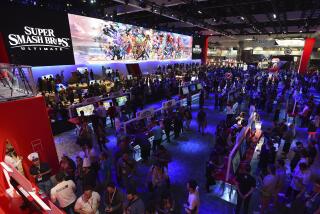Armed With New Game Consoles, Firms Play Hard
- Share via
The $7-billion battle to control digital entertainment escalates today at the Los Angeles Convention Center, where Microsoft Corp. and the world’s leading video game companies will square off and spend tens of millions of dollars trying to outshoot one another.
Their goal, and the crux of this fierce rivalry, is to dominate a new generation of video game machines. More than just toys, these devices are all-in-one entertainment centers that let people play games, listen to music CDs, watch DVD movies and surf the Web from their TV sets.
But after the week’s star-studded parties end, and the lavish booths at the Electronic Entertainment Expo are torn down, the fight to control what people see in their living rooms will continue to rage across Southern California.
“We’re really shocked how much of the [video] game community is based down south,” said Ed Fries, vice president of game publishing for Redmond, Wash.-based Microsoft. “We need to be at E3. [And] we need the developers down there to support us.”
So does Sony Corp., Sega Enterprises and Nintendo of America. For months, all four companies have been wooing Hollywood studios and software makers throughout California to develop a strong line of game titles for their new devices: Microsoft’s X-Box, Sony’s PlayStation2, Sega’s Dreamcast and Nintendo’s Dolphin.
Desperate to get the “killer app” that will persuade consumers to spend at least $300 on a video game machine, the behemoths have tried everything from reportedly offering $20 million for making a single game, to threatening to shun developers that refuse to sign deals.
Companies with hot entertainment properties--such as Warner Bros., which owns the rights to box-office smash “The Matrix” and to the first three titles of the best-selling Harry Potter books--are facing vicious bidding wars normally seen in Hollywood over film projects.
“It’s very unusual, but I think that it’s emblematic of what we’ll see in the future,” said Michael Harkavy, vice president of worldwide publishing and interactive entertainment for Warner Bros.’ consumer products. “This is not just about getting the gaming rights, and everyone knows it. This is about building a community around the gaming experience, and extending that brand out into a franchise.”
Pushing that brand onto the Internet is crucial, say hardware makers. Much of the excitement over these new boxes stems from their Internet capability, which allow game players to compete live against rivals around the world. That Internet capacity also is critical in elevating the device to a PC substitute.
Computer World Shifts to Game World
Beyond mere entertainment, these new game machines reflect a fundamental shift in the computer world, away from personal computers and toward television and other digital appliances that are connected to the Internet and to each other.
“Everyone’s being extremely aggressive,” said Robert Kotick, chief executive of Santa Monica-based Activision Inc., one of the industry’s leading game publishers. “Microsoft doesn’t have a lot of staff allocated to this [in comparison to Sony], but they are making a lot of progress.”
Game developers and software publishers say they were first approached by Microsoft officials about the X-Box late last summer. Since then, Microsoft has been structuring a variety of deals, from providing seed funding for software start-ups, to signing longer-term deals with large publishers such as Activision.
Microsoft declined to comment on the financial specifics of any deals.
“We have been running around with a team of product planners who are finding developers to sign up,” said Kevin Bachus, director of third-party relations for Microsoft’s console gaming group. “I’d like to have about 30 [games] in place this year, but I don’t know which one will be the killer game. I plan to have more than one killer game, actually.”
Such hunger for software should mean a financial boom for the developers. But reaping the rewards of this scramble won’t be seen for a least a year, software executives say.
Part of the reason is the skyrocketing budgets for making a console game.
“There is a massive amount of special effects in games because of the technology of the box,” said Yoshi Maruyama, vice chairman of software publisher Square Electronic Arts in Costa Mesa, the U.S. arm of Japanese game firm Square Co. “A couple years ago, you could build a PlayStation game for a couple hundred thousand dollars. Now, the average [console] game will cost between $5 million and $10 million. We invested $30 million for developing [top-selling titles] ‘Final Fantasy 7,’ and another $30 million for ‘Final Fantasy 8.’ ”
Adding to the problem is timing. Every four years, the industry undergoes a major technology transition, as it waits for new generations of game hardware to be launched. As consumers wait for the new systems, sales on products slump and game makers feel a financial pinch.
On Tuesday, Activision reported a fiscal fourth quarter net loss. The company also predicted a loss for its first fiscal quarter, and forecasted its own sales would fall 10% in fiscal 2001, and earnings would drop 30% for the year, during this hardware shift. And last week, Electronic Arts told analysts that it expects overall industry sales to drop 5% to 10% in 2000, in comparison to 1999.
“The money that [the hardware makers] are throwing around is not enough,” said Brian Fargo, chief executive of game publisher Interplay Entertainment Corp. in Irvine. “Right now, it’s all about how well, and how fast, someone like Sony or Microsoft can execute.”
Electronic giants have tried--and failed--to persuade the public in the past to buy into multi-function machines. Philips Electronics bombed with its CD-I machines, which could be used to play games and music CDs.
Then, there was 3DO Co.’s ballyhooed attempt in the mid-’90s to promote an all-in-one machine. The various technologies shoved the machine’s price tag to $700, which proved to be too high for most consumers. The machine flopped, the company shriveled financially, and several software developers that made games for the 3DO eventually went out of business.
But today’s devices stand a better chance of success than their predecessors. Again, the key is cost: The technology used to run game consoles, DVD players and Internet devices is similar enough--and cheap enough--to make sense to bundle them inside one box.
The other element is timing. Every few years, console makers and software developers redesign their machines and take advantage of the latest technology, giving upstarts a chance to seize control over the market.
Competition Runs High in Gaming Circles
The result has been a constant game of corporate one-upmanship. In 1987, Nintendo dethroned Atari Corp. Eight years later, then-newcomer Sony passed by Nintendo.
Reflecting upon the past, Nintendo officials admitted that one key to Sony’s success was software.
“Without great software, the hardware system is just a box,” said Minoru Arakawa, president of Nintendo of America.
Hyping the latest software titles--the bounty of months of wheeling and dealing--is what E3 is all about. An orgy of digital promise burst across the floor of the convention center Wednesday, as workers set up screens that blazed with dazzling images.
Blocks away, company executives from the big four hardware firms spent hours belittling their rivals and tantalizing audiences with their vision of high-tech fun.
Sega employees in electric-blue wigs hawked hot dogs and enticed visitors to spend the afternoon with a TV and a hand-held joystick. Across the street, officials with Sony of America used several of their new machines to play endless loops of Keanu Reeves shooting a gun in “The Matrix.”
The PlayStation2 debuted in Japan in March amid enormous demand: Consumers snatched up nearly 1 million machines in the first three days.
So analysts were shocked Wednesday, when Sony announced that it would ship only 1 million units to North America when it launches its $299 machine here Oct. 26.
That averages out to about 50 machines per retail outlet, Sony officials said. Additional machines would be available in the U.S. by March 2001.
Analysts Question Tight-Supply Tactic
“Demand will outstrip supply,” Jack Tretton, vice president of sales for Sony of America, said with a shrug. “That’s just what goes on with something as hot as PlayStation2.”
But analysts warned that, regardless of its lineup of games, a product drought could hurt Sony, both among customers and within the software community.
“Customers are going to be dissatisfied that they’ve heard all this buzz, and they can’t buy the machine,” said Van Baker, vice president of the e-business group at research firm Dataquest. “It also narrows the window of lead time Sony has over Microsoft and Nintendo.”
Who will win this round will remain unclear until fall 2001, when Microsoft plans to start selling its X-Box. Nintendo’s Dolphin will be out by early next year. And Sega’s Dreamcast, already released, has sold nearly 5 million units worldwide.





